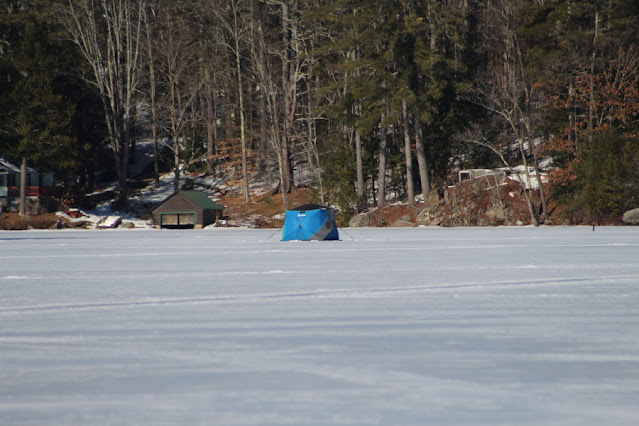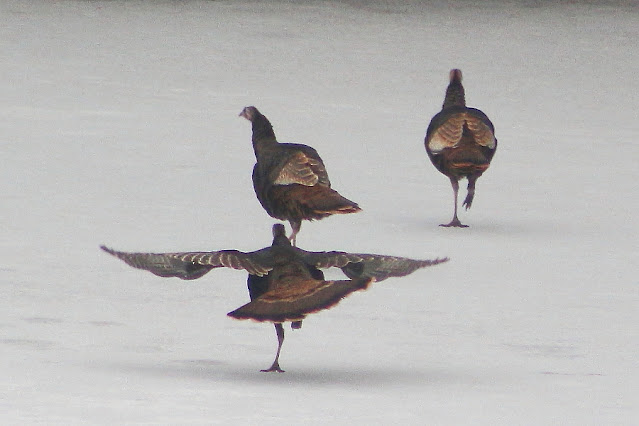It started with a ground invasion of just a few birds walking along the ice, stopping now and then to peck at something, probably pine and hemlock seeds that blew onto the frozen lake. Sometimes they would break into a fast trot.
I was intrigued by how they engage their tail feathers when they run. They seem to spread them out, perhaps using them as stabilizers to increase balance as they must be rather top-heavy up on top of those long spindly legs.
Occasionally they would take off and fly a few yards.
Their flight feathers are beautiful and I was surprised to see how much space there is between feathers when flying, at least at times of landing and take off.
The flock made their way along the shore to an open plateau under a big hemlock tree that probably dispersed a large quantity of seeds.
Reinforcements soon arrived from the opposite flank via a ground route, and the two fleets converged to refuel.
 |
| We counted thirteen birds in all. |
After filling their tanks, the whole squadron took off and flew a single-file route at low altitude across the cove to the far shoreline. I guess they didn't want to be exposed in the open for as long as it would take to trot back under cover. I saw them mid-flight and wasn't able to catch a picture, but they are surprisingly graceful flyers, and they would even glide on fixed wings for two or three seconds at a time.
In winter, multiple hens and their broods combine, sometimes forming flocks of many dozens of birds. Before mating season the young males ("jakes") will be evicted and males and females will separate into single-sex flocks. NH Fish and Game is asking people to report winter sightings of turkey flocks; if you see a flock you can report it here. It's too bad this flock appeared one day before the Backyard Bird Count - which continues today if you want to participate.
Elsewhere on the lake I found other food sources available for turkeys as well as other birds. There were red berries
and black berries.
Did you notice the exciting aspect of that shrub?
 |
| Black chokeberry |
 |
| Red buds pushing out! |
It was warm again this weekend, so warm that the fishing derby has limited fishing options which will drive more anglers to the smaller lakes such as Wicwas and Waukewan which have safer ice conditions. As of yesterday I measured 10.5" of ice on Wicwas.
 |
| Bob house on Wicwas early in the week, the first of many. |
In fact it was so warm yesterday, 57.4 degrees here at the lake, that we had an early taste of mud season. Still, with two calm and cold nights, ice-in on Lake Winnipesaukee was declared on Friday at 10:30am. Be safe out there.
In case you're interested in the weather conditions at the lake, Linda gave me a weather station for Christmas which I put on line, so anytime you want to check the weather at Wicwas you can use this link: Lake Wicwas Weather Station You can also review historical data on a daily, weekly, or monthly basis back to the date I installed it.
The beautiful weather this week had lots of people out on the lakes and up in the mountains enjoying the bright sunshine and blue skies. I trekked the Welch-Dickey loop and it was as pretty as ever.
 |
| Heading up Mt. Welch. |
Prior warm days had helped create some impressive ice flows on the ledges.There's a great view of the Kinsman and the Franconia Ranges from the north slope of Welch.
 |
| L to R: S. and N. Kinsman, the Cannonballs, Cannon, then Liberty, Lincoln, and Lafayette. |
These White Mountains are living up to their name this winter!










Scott! A thank you for another lesson on the wilds of our earth. T
ReplyDelete